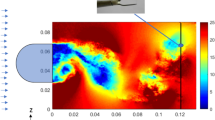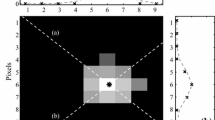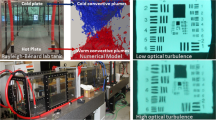Abstract
A theoretical model to determine the effect of the size of the interrogation window in particle image velocimetry measurements of turbulent flows is presented. The error introduced by the window size in two-point velocity statistics, including velocity autocovariance and structure functions, is derived for flows that are homogeneous within a 2D plane or 3D volume. This error model is more general than those previously discussed in the literature and provides a more direct method of correcting biases in experimental data. Within this model framework, simple polynomial approximations are proposed to provide a quick estimation of the effect of the averaging on these statistics. The error model and its polynomial approximation are validated using statistics of homogeneous isotropic turbulence obtained in a physical experiment and in a direct numerical simulation. The results demonstrate that the present formulation is able to correctly estimate the turbulence statistics, even in the case of strong smoothing due to a large interrogation window. We discuss how to use these results to correct experimental data and to aid the comparison of numerical results with laboratory data.








Similar content being viewed by others
References
Adrian RJ (2005) Twenty years of particle image velocimetry. Exp Fluids 39:159–169
Batchelor GK (1953) The theory of homogeneous turbulence. Cambridge University Press, Cambridge
Bellani G, Variano EA (2014) Homogeneity and isotropy in a laboratory turbulent flow. Exp Fluids 55:1646
Bellani G, Byron ML, Collignon AG, Meyer CR, Variano EA (2012) Shape effects on turbulent modulation by large nearly neutrally buoyant particles. J Fluid Mech 712:41–60
Chen J, Katz J (2005) Elimination of peak-locking error in PIV analysis using the correlation mapping method. Meas Sci Technol 16:1605
Dryden HL, Schubauer GB, Mock WC, Skramstad HK (1937) Measurements of intensity and scale of wind-tunnel turbulence and their relation to the critical Reynolds number of spheres. NACA Technical Report 581
Foucaut JM, Carlier J, Stanislas M (2004) Piv optimization for the study of turbulent flow using spectral analysis. Meas Sci Technol 15:1046
Frenkiel FN (1949) The influence of the length of a hot wire on the measurements of turbulence. Phys Rev 75:1263–1264
Gibert M, Xu H, Bodenschatz E (2010) Inertial effects on two-particle relative dispersion in turbulent flows. EPL 90(64):005
Giordano R, Astarita T (2009) Spatial resolution of the stereo PIV technique. Exp Fluids 46:643–658
Kähler CJ, Scharnowski S, Cierpka C (2012) On the resolution limit of digital particle image velocimetry. Exp Fluids 52:1629–1639
Kolmogorov A (1941) The local structure of turbulence in incompressible viscous fluid for very large Reynolds numbers. Dokl Akad Nauk SSSR 30:299–303
Lavoie P, Avallone G, De Gregorio F, Romano GP, Antonia RA (2007) Spatial resolution of piv for the measurement of turbulence. Exp Fluids 43:39–51
Lundbladh A, Henningson DS, Johansson AV (1992) An efficient spectral integration method for the solution of the Navier–Stokes equations. FFA TN 28
Nobach H, Damaschke N, Tropea C (2005) High-precision sub-pixel interpolation in particle image velocimetry image processing. Exp Fluids 39:299–304
Poelma C, Westerweel J, Ooms G (2006) Turbulence statistics from optical whole-field measurements in particle-laden turbulence. Exp Fluids 40:347–363
Pope S (2000) Turbulent flows. Cambridge University Press, Cambridge
Raffel M, Willert CE, Wereley ST, Kompenhans J (2001) Particle image velocimetry. Spinger, Berlin
Rogallo RS (1981) Numerical experiments in homogeneous turbulence. NASA Tech Memo 81315
Saarenrinne P, Piirto M (2000) Turbulent kinetic energy dissipation rate estimation from PIV velocity vector fields. Exp Fluids 29:S300–S307
Saarenrinne P, Piirto M, Eloranta H (2001) Experiences of turbulence measurement with PIV. Meas Sci Technol 12:1904
Saddoughi SG, Veeravalli SV (1994) Local isotropy in turbulent boundary layers at high Reynolds number. J Fluid Mech 268:333–372
Scarano F (2002) Iterative image deformation methods in PIV. Meas Sci Technol 13:R1. doi:10.1088/0957-0233/13/1/201
Scarano F (2003) Theory of non-isotropic spatial resolution in PIV. Exp Fluids 35:268–277
Scarano F, Moore P (2012) An advection-based model to increase the temporal resolution of PIV time series. Exp Fluids 52:919–933
Scarano F, Riethmuller ML (2000) Advances in iterative multigrid PIV image processing. Exp Fluids 29:S051–S060
Scharnowski S, Hain R, Kähler CJ (2012) Reynolds stress estimation up to single-pixel resolution using PIV-measurements. Exp Fluids 52:985–1002
Segalini A, Cimarelli A, Rüedi J, De Angelis E, Talamelli A (2011a) Effect of the spatial filtering and alignment error of hot-wire probes in a wall-bounded turbulent flow. Meas Sci Technol 22(105):408
Segalini A, Örlü R, Schlatter P, Alfredsson PH, Rüedi J, Talamelli A (2011b) A method to estimate turbulence intensity and transverse Taylor microscale in turbulent flows from spatially averaged hot-wire data. Exp Fluids 51:693–700
Sreenivasan KR (1984) On the scaling of the turbulence energy dissipation rate. Phys Fluids 27(5):1048–1050
Sreenivasan KR (1995) On the universality of the kolmogorov constant. Phys Fluids 7(11):2778
Stanislas M, Okamoto K, Kähler CJ, Westerweel J (2005) Main results of the second international PIV challenge. Exp Fluids 39:170–191
Stanislas M, Okamoto K, Kähler CJ, Westerweel J, Scarano F (2008) Main results of the third international PIV challenge. Exp Fluids 45:27–71
Talamelli A, Segalini A, Örlü R, Schlatter P, Alfredsson PH (2013) Correcting hot-wire spatial resolution effects in third- and fourth-order velocity moments in wall-bounded turbulence. Exp Fluids 54:1496
Tanaka T, Eaton JK (2007) A correction method for measuring turbulence kinetic energy dissipation rate by PIV. Exp Fluids 42:893–902
Variano EA, Cowen EA (2008) A random-jet-stirred turbulence tank. J Fluid Mech 604:1–32
Vincent A, Meneguzzi M (1991) The spatial structure and statistical properties of homogeneous turbulence. J Fluid Mech 225:1–20
Westerweel J (1997) Fundamentals of digital particle image velocimetry. Meas Sci Technol 8:1379–1392
Westerweel J, Dabiri D, Gharib M (1997) The effect of a discrete window offset on the accuracy of cross-correlation analysis of digital PIV recordings. Exp Fluids 23:20–28
Wyngaard JC (1968) Measurement of small-scale turbulence structure with hot wires. J Phys E Sci Instrum 1:1105
Author information
Authors and Affiliations
Corresponding author
Relationship between interrogation window and measured velocity
Relationship between interrogation window and measured velocity
To quantify the effect of the interrogation window on the measured velocity, let us consider two PIV images taken at two different instants \(t_0\) and \(t_1=t_0+\Delta t\). It is expected that these images will be black (zero light intensity) almost everywhere, with the exception of some points where the laser light reflected by the particles is detected. We assume now a square interrogation area, \(I_0\), of size \(L\) where \(N\) particles are located in the first image, and another interrogation area in the second image, \(I_1\), of the same size as \(I_0\) but translated with a convection velocity \(\varvec{V}_m\), for the moment undefined. The location of the illuminated points can be labeled as \(\varvec{x}_{0,i}\) in \(I_0\) and \(\varvec{x}_{1,i}=\varvec{x}_{0,i}+\left( \varvec{V}_i-\varvec{V}_m\right) \Delta t\) in \(I_1\) with \(i\in \lbrace 1,2,...,N\rbrace\), where \(\varvec{V}_i\) denotes the average velocity of the \(i^{\mathrm{th}}\)-particle between \(t_0\) and \(t_1\). It is assumed that there are only a negligible number of particles leaving the domain determined by the interrogation area, so that the present analysis has general validity. The light intensity distribution over the two interrogations areas can be expressed as
where \(\rho \left( \varvec{x}\right)\) is a function that represents the light intensity around a particle located at the origin. For the sake of simplicity, it will be assumed to be a rapidly decaying Gaussian.
The cross-correlation operator between the two images can now be introduced as
where \(D\) is a square domain of size \(L\) that includes the interrogation area. The cross-correlation, together with Eq. (22), becomes
The maximum of the cross-correlation function identifies the optimal interrogation window displacement, \(\varvec{\tau }\), that ensures the highest correlation. Therefore, \(\varvec{V}_m\) can be seen as the convective velocity maximizing \(R\left( {0}\right)\). The maximum of the cross-correlation is readily obtained by imposing that the gradient must be zero at \(\varvec{\tau }={0}\) so that
To proceed further, it is possible to assume that the term \(\left( \varvec{V}_j-\varvec{V}_m\right) \Delta t\) in Eq. (25) is small, so that a simple Taylor expansion can be used
The first integral is zero for \(i=j\) since the function \(\rho\) is assumed to be isotropic, while for \(i\ne j\) is approximately zero since it is assumed that no particles lie near the boundaries. The second integral is nonzero if \(i=j\) and becomes negligible otherwise (since \(\rho\) is rapidly decaying). Therefore, Eq. (26) can be approximated by considering only the second integral when \(i=j\), and by noting that \(\rho\) is assumed to be the same for all particles
The measured velocity is therefore the arithmetic mean of the average velocity (within \(\Delta t\)) of the \(N\) particles inside the interrogation area \(D\).
Since the particles are assumed to be embedded in a velocity field \(\varvec{V}\left( \varvec{x},t\right)\) that is homogeneous in the image plane, they are uniformly distributed in space. The expected velocity of the generic \(i{\mathrm{th}}\)-particle inside \(D\) is statistically equal to the average flow velocity, assuming ideal particles with no inertia, therefore
and the measured velocity can be expressed using Eq. (27) as
In conclusion, the measured velocity is approximately equal to the integral average of the velocity field inside the interrogation area.
Rights and permissions
About this article
Cite this article
Segalini, A., Bellani, G., Sardina, G. et al. Corrections for one- and two-point statistics measured with coarse-resolution particle image velocimetry. Exp Fluids 55, 1739 (2014). https://doi.org/10.1007/s00348-014-1739-z
Received:
Revised:
Accepted:
Published:
DOI: https://doi.org/10.1007/s00348-014-1739-z




